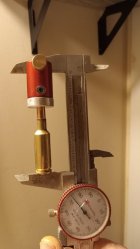NC/Br Shooter
Silver $$ Contributor
As the title suggests, I went at it again measuring Jam with Sierra 107s. I'm doing so by seating the bullet long and clambering it,then measuring using the Hornady tool pictured. I did this with 20 pieces. After I measured 5, I thought hey! All measured within 2 thou. Then 10 pieces. All within 3 thou. Man, I measured 20 pieces. All within 3 thousandth of each other.
Now, all the bass is 3x fired,,6bra and a new box of 107s.
I've used this method on my other bullets in the past but never get that level of consistency.
Is Sierra just that consistent ?
Is it just maybe a good lot?
I'm comparing them to berger 108s that I have.
This measuring method isn't new to me. I've just never found a bullet that gave me that level of measure one right after the other. I know it's where the ojive hits the chamber. I'm guessing maybe the 108s have move slope at that particular spot throwing the readings off. Any thoughts welcome. I'd just like to hear what yall think about it.
Thanks
Now, all the bass is 3x fired,,6bra and a new box of 107s.
I've used this method on my other bullets in the past but never get that level of consistency.
Is Sierra just that consistent ?
Is it just maybe a good lot?
I'm comparing them to berger 108s that I have.
This measuring method isn't new to me. I've just never found a bullet that gave me that level of measure one right after the other. I know it's where the ojive hits the chamber. I'm guessing maybe the 108s have move slope at that particular spot throwing the readings off. Any thoughts welcome. I'd just like to hear what yall think about it.
Thanks











